Managing Decision Making and Employee Turnover at Pan Pacific Perth
VerifiedAdded on 2020/03/13
|14
|2841
|71
Case Study
AI Summary
This case study analyzes the managerial decision-making processes at Pan Pacific Perth, a luxury hotel facing challenges related to high employee turnover. The report identifies issues such as job pressure, inadequate incentives, and insufficient work-life balance as root causes. It explores various solutions, including hiring the right individuals, providing competitive compensation, and offering opportunities for development. The study recommends an incentive-based monetary benefit program as the most effective solution, outlining a 12-week implementation plan with employee feedback surveys for continuous improvement. The goal is to improve employee motivation, increase productivity, and reduce turnover within the organization. The report includes a decision matrix for evaluating solutions and concludes with the expectation that the proposed strategies will enhance the hotel's business performance and employee satisfaction.
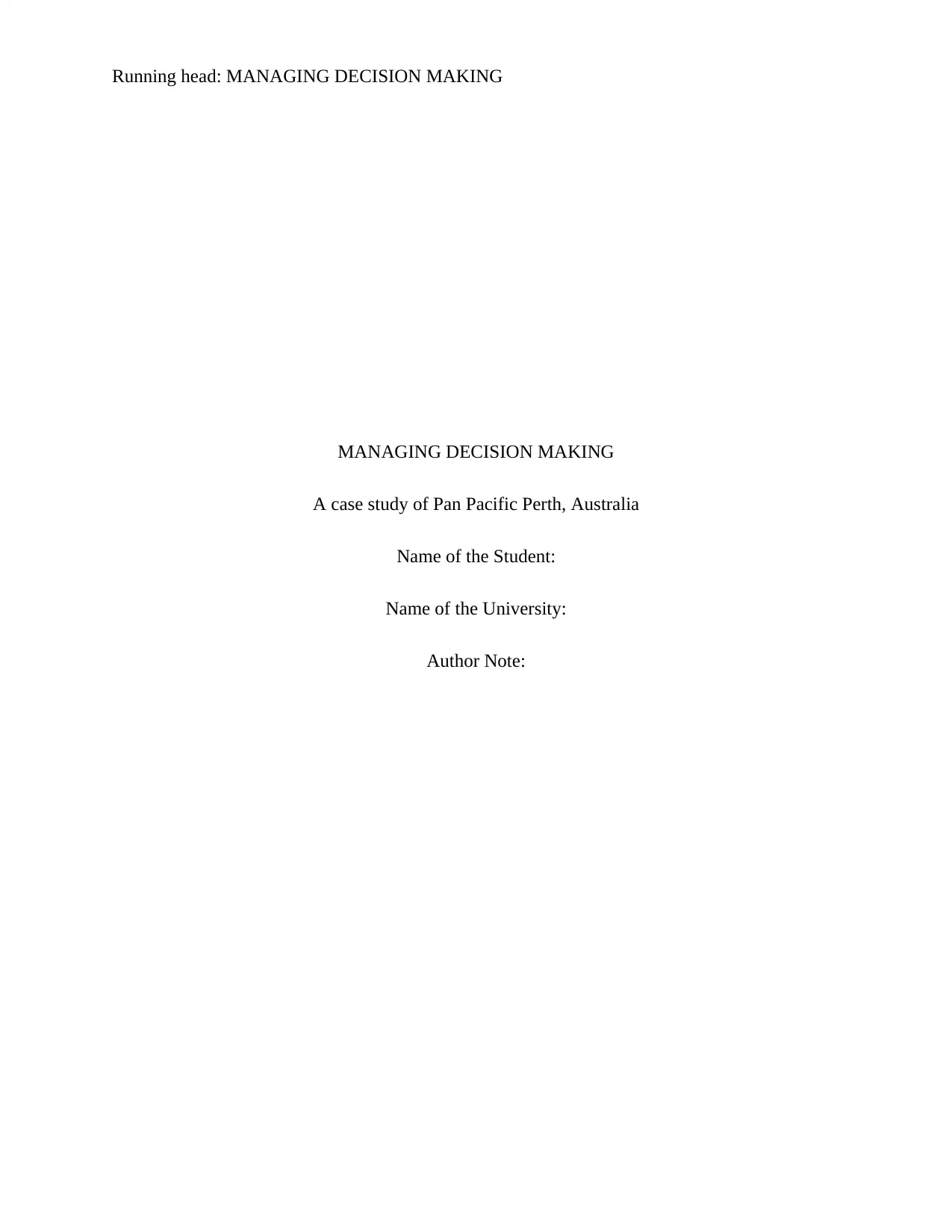
Running head: MANAGING DECISION MAKING
MANAGING DECISION MAKING
A case study of Pan Pacific Perth, Australia
Name of the Student:
Name of the University:
Author Note:
MANAGING DECISION MAKING
A case study of Pan Pacific Perth, Australia
Name of the Student:
Name of the University:
Author Note:
Secure Best Marks with AI Grader
Need help grading? Try our AI Grader for instant feedback on your assignments.
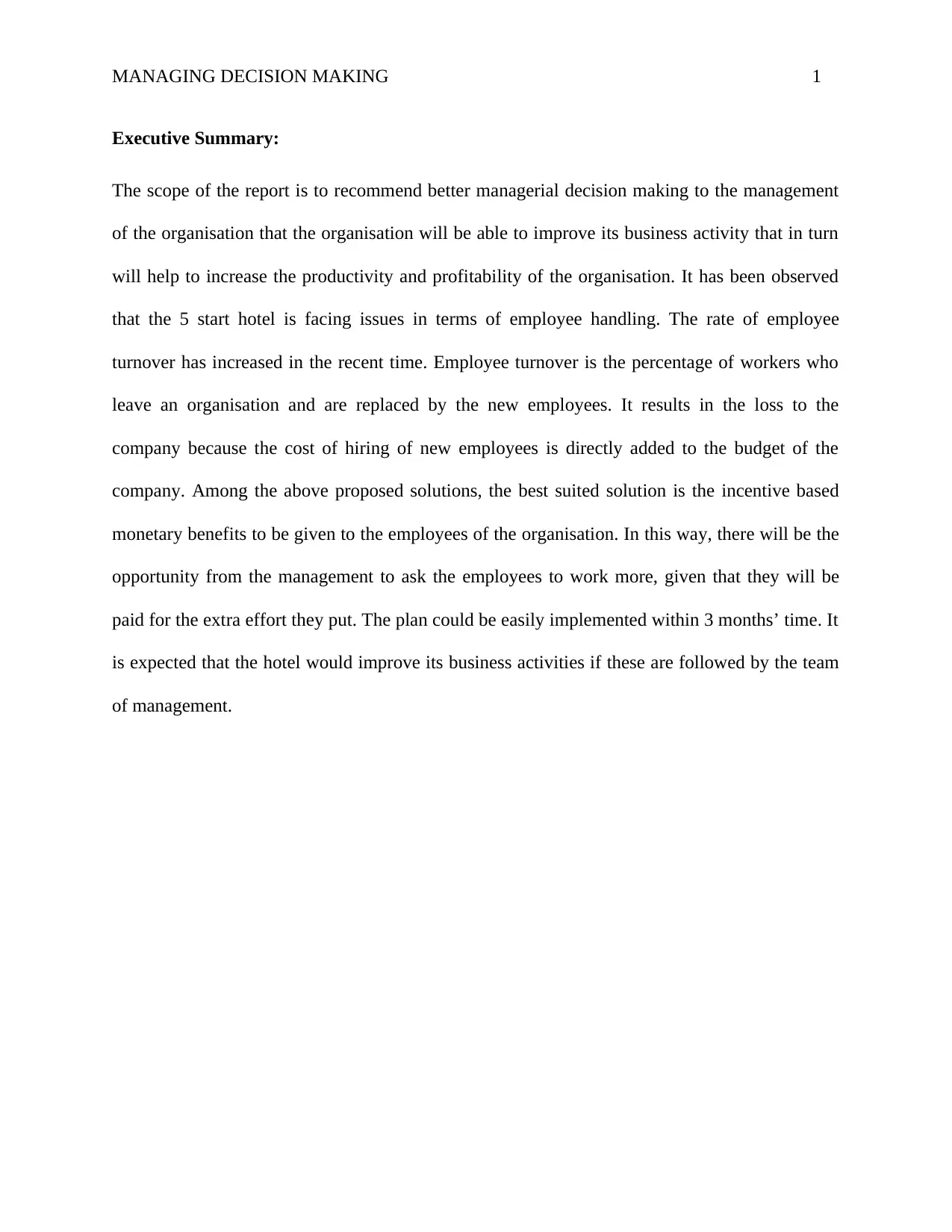
MANAGING DECISION MAKING 1
Executive Summary:
The scope of the report is to recommend better managerial decision making to the management
of the organisation that the organisation will be able to improve its business activity that in turn
will help to increase the productivity and profitability of the organisation. It has been observed
that the 5 start hotel is facing issues in terms of employee handling. The rate of employee
turnover has increased in the recent time. Employee turnover is the percentage of workers who
leave an organisation and are replaced by the new employees. It results in the loss to the
company because the cost of hiring of new employees is directly added to the budget of the
company. Among the above proposed solutions, the best suited solution is the incentive based
monetary benefits to be given to the employees of the organisation. In this way, there will be the
opportunity from the management to ask the employees to work more, given that they will be
paid for the extra effort they put. The plan could be easily implemented within 3 months’ time. It
is expected that the hotel would improve its business activities if these are followed by the team
of management.
Executive Summary:
The scope of the report is to recommend better managerial decision making to the management
of the organisation that the organisation will be able to improve its business activity that in turn
will help to increase the productivity and profitability of the organisation. It has been observed
that the 5 start hotel is facing issues in terms of employee handling. The rate of employee
turnover has increased in the recent time. Employee turnover is the percentage of workers who
leave an organisation and are replaced by the new employees. It results in the loss to the
company because the cost of hiring of new employees is directly added to the budget of the
company. Among the above proposed solutions, the best suited solution is the incentive based
monetary benefits to be given to the employees of the organisation. In this way, there will be the
opportunity from the management to ask the employees to work more, given that they will be
paid for the extra effort they put. The plan could be easily implemented within 3 months’ time. It
is expected that the hotel would improve its business activities if these are followed by the team
of management.
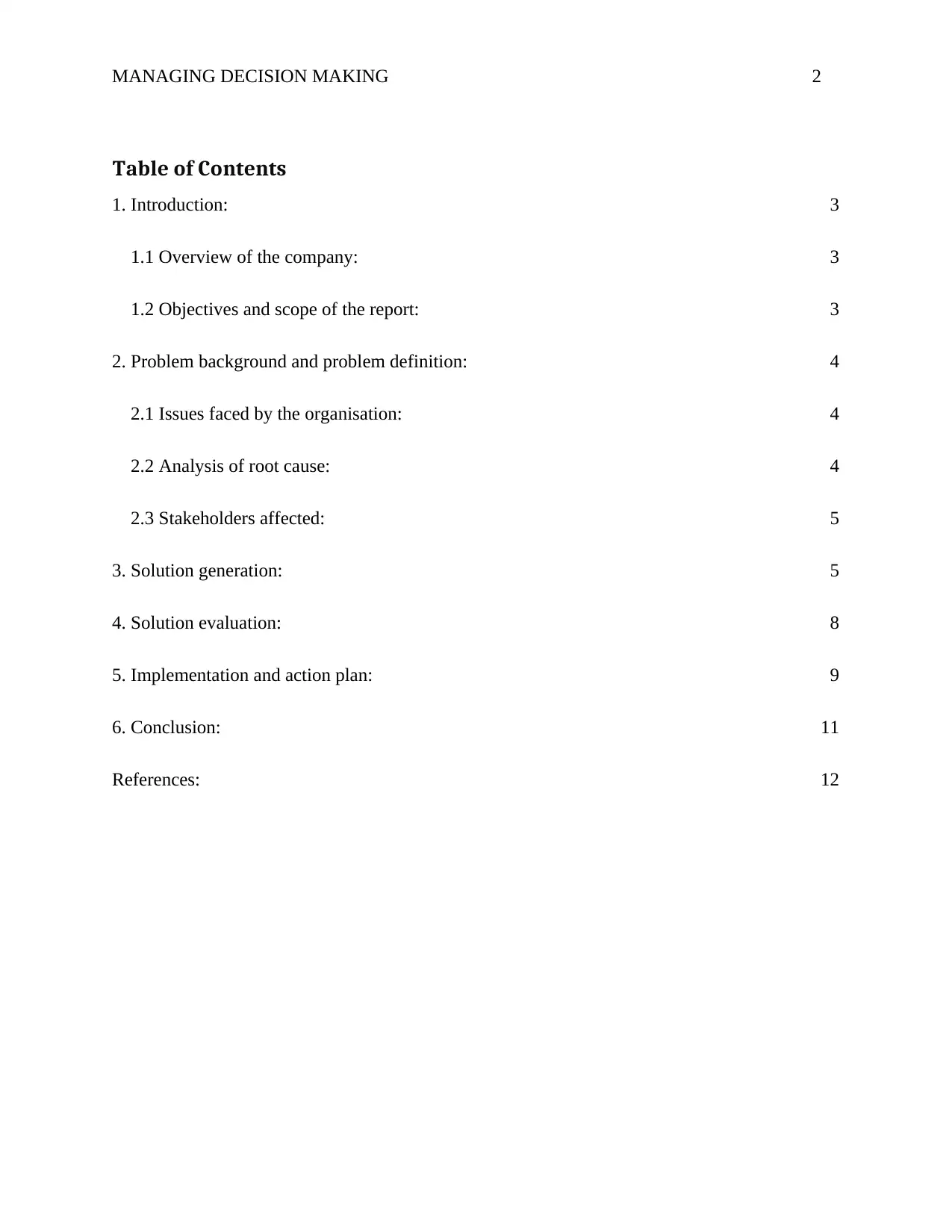
MANAGING DECISION MAKING 2
Table of Contents
1. Introduction: 3
1.1 Overview of the company: 3
1.2 Objectives and scope of the report: 3
2. Problem background and problem definition: 4
2.1 Issues faced by the organisation: 4
2.2 Analysis of root cause: 4
2.3 Stakeholders affected: 5
3. Solution generation: 5
4. Solution evaluation: 8
5. Implementation and action plan: 9
6. Conclusion: 11
References: 12
Table of Contents
1. Introduction: 3
1.1 Overview of the company: 3
1.2 Objectives and scope of the report: 3
2. Problem background and problem definition: 4
2.1 Issues faced by the organisation: 4
2.2 Analysis of root cause: 4
2.3 Stakeholders affected: 5
3. Solution generation: 5
4. Solution evaluation: 8
5. Implementation and action plan: 9
6. Conclusion: 11
References: 12
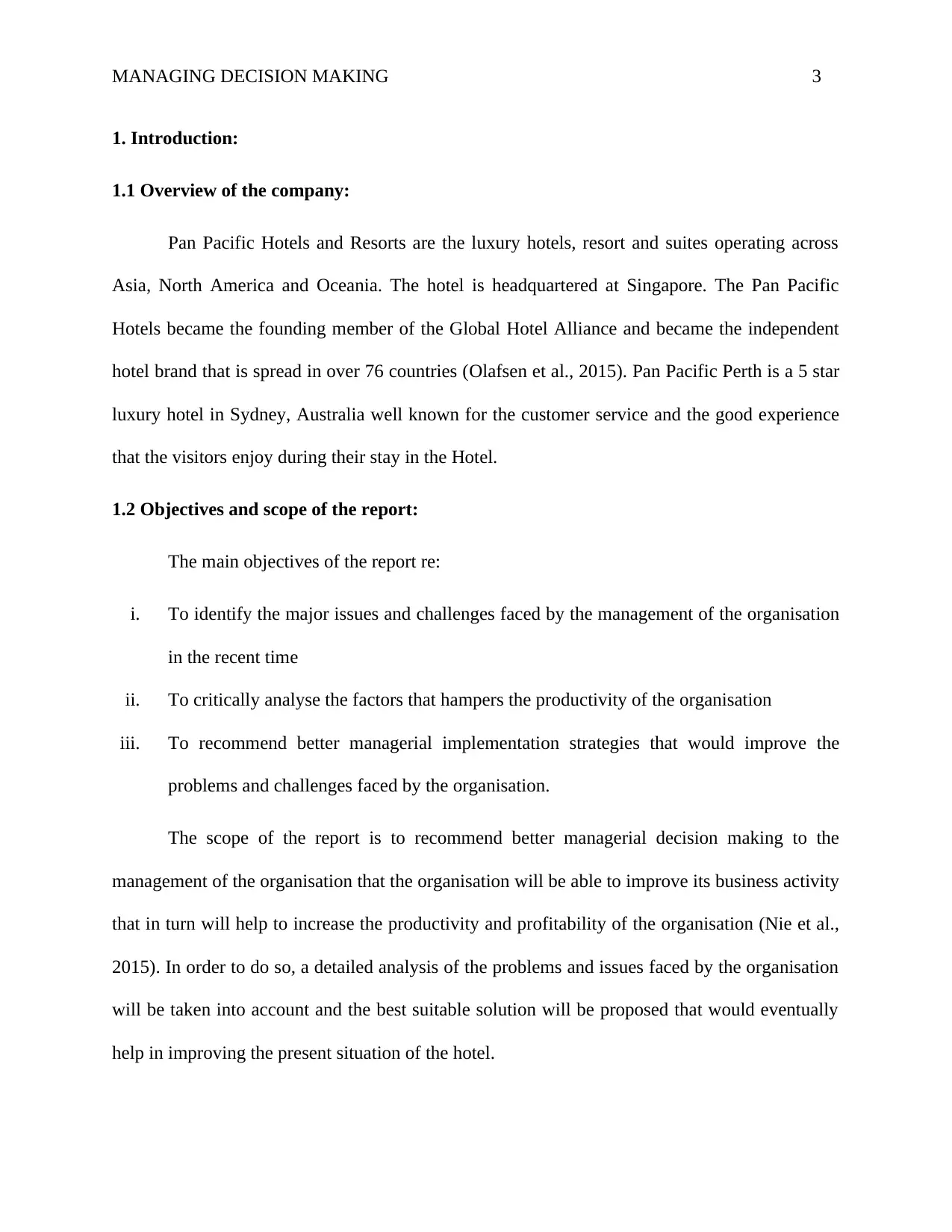
MANAGING DECISION MAKING 3
1. Introduction:
1.1 Overview of the company:
Pan Pacific Hotels and Resorts are the luxury hotels, resort and suites operating across
Asia, North America and Oceania. The hotel is headquartered at Singapore. The Pan Pacific
Hotels became the founding member of the Global Hotel Alliance and became the independent
hotel brand that is spread in over 76 countries (Olafsen et al., 2015). Pan Pacific Perth is a 5 star
luxury hotel in Sydney, Australia well known for the customer service and the good experience
that the visitors enjoy during their stay in the Hotel.
1.2 Objectives and scope of the report:
The main objectives of the report re:
i. To identify the major issues and challenges faced by the management of the organisation
in the recent time
ii. To critically analyse the factors that hampers the productivity of the organisation
iii. To recommend better managerial implementation strategies that would improve the
problems and challenges faced by the organisation.
The scope of the report is to recommend better managerial decision making to the
management of the organisation that the organisation will be able to improve its business activity
that in turn will help to increase the productivity and profitability of the organisation (Nie et al.,
2015). In order to do so, a detailed analysis of the problems and issues faced by the organisation
will be taken into account and the best suitable solution will be proposed that would eventually
help in improving the present situation of the hotel.
1. Introduction:
1.1 Overview of the company:
Pan Pacific Hotels and Resorts are the luxury hotels, resort and suites operating across
Asia, North America and Oceania. The hotel is headquartered at Singapore. The Pan Pacific
Hotels became the founding member of the Global Hotel Alliance and became the independent
hotel brand that is spread in over 76 countries (Olafsen et al., 2015). Pan Pacific Perth is a 5 star
luxury hotel in Sydney, Australia well known for the customer service and the good experience
that the visitors enjoy during their stay in the Hotel.
1.2 Objectives and scope of the report:
The main objectives of the report re:
i. To identify the major issues and challenges faced by the management of the organisation
in the recent time
ii. To critically analyse the factors that hampers the productivity of the organisation
iii. To recommend better managerial implementation strategies that would improve the
problems and challenges faced by the organisation.
The scope of the report is to recommend better managerial decision making to the
management of the organisation that the organisation will be able to improve its business activity
that in turn will help to increase the productivity and profitability of the organisation (Nie et al.,
2015). In order to do so, a detailed analysis of the problems and issues faced by the organisation
will be taken into account and the best suitable solution will be proposed that would eventually
help in improving the present situation of the hotel.
Secure Best Marks with AI Grader
Need help grading? Try our AI Grader for instant feedback on your assignments.
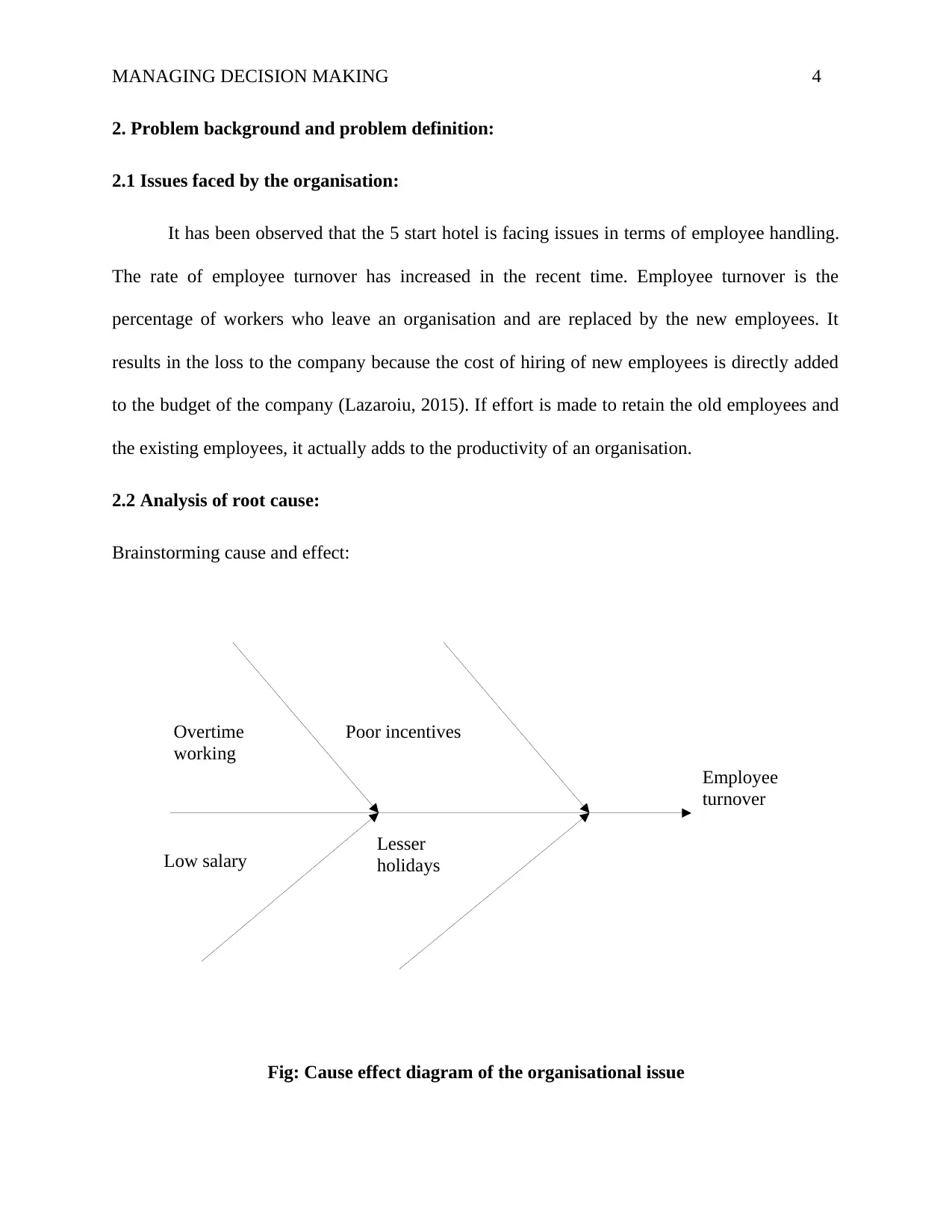
Overtime
working
Poor incentives
Lesser
holidaysLow salary
Employee
turnover
MANAGING DECISION MAKING 4
2. Problem background and problem definition:
2.1 Issues faced by the organisation:
It has been observed that the 5 start hotel is facing issues in terms of employee handling.
The rate of employee turnover has increased in the recent time. Employee turnover is the
percentage of workers who leave an organisation and are replaced by the new employees. It
results in the loss to the company because the cost of hiring of new employees is directly added
to the budget of the company (Lazaroiu, 2015). If effort is made to retain the old employees and
the existing employees, it actually adds to the productivity of an organisation.
2.2 Analysis of root cause:
Brainstorming cause and effect:
Fig: Cause effect diagram of the organisational issue
working
Poor incentives
Lesser
holidaysLow salary
Employee
turnover
MANAGING DECISION MAKING 4
2. Problem background and problem definition:
2.1 Issues faced by the organisation:
It has been observed that the 5 start hotel is facing issues in terms of employee handling.
The rate of employee turnover has increased in the recent time. Employee turnover is the
percentage of workers who leave an organisation and are replaced by the new employees. It
results in the loss to the company because the cost of hiring of new employees is directly added
to the budget of the company (Lazaroiu, 2015). If effort is made to retain the old employees and
the existing employees, it actually adds to the productivity of an organisation.
2.2 Analysis of root cause:
Brainstorming cause and effect:
Fig: Cause effect diagram of the organisational issue
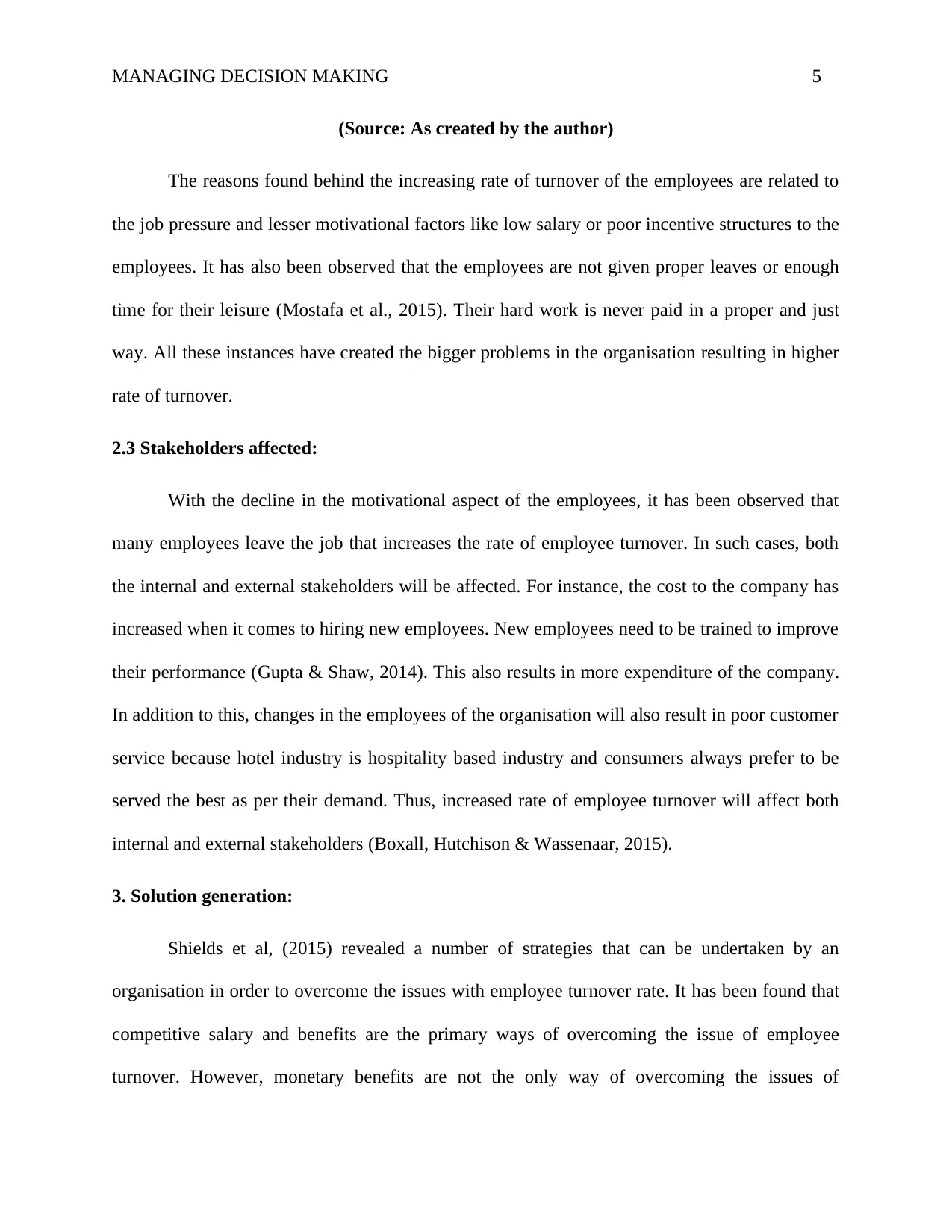
MANAGING DECISION MAKING 5
(Source: As created by the author)
The reasons found behind the increasing rate of turnover of the employees are related to
the job pressure and lesser motivational factors like low salary or poor incentive structures to the
employees. It has also been observed that the employees are not given proper leaves or enough
time for their leisure (Mostafa et al., 2015). Their hard work is never paid in a proper and just
way. All these instances have created the bigger problems in the organisation resulting in higher
rate of turnover.
2.3 Stakeholders affected:
With the decline in the motivational aspect of the employees, it has been observed that
many employees leave the job that increases the rate of employee turnover. In such cases, both
the internal and external stakeholders will be affected. For instance, the cost to the company has
increased when it comes to hiring new employees. New employees need to be trained to improve
their performance (Gupta & Shaw, 2014). This also results in more expenditure of the company.
In addition to this, changes in the employees of the organisation will also result in poor customer
service because hotel industry is hospitality based industry and consumers always prefer to be
served the best as per their demand. Thus, increased rate of employee turnover will affect both
internal and external stakeholders (Boxall, Hutchison & Wassenaar, 2015).
3. Solution generation:
Shields et al, (2015) revealed a number of strategies that can be undertaken by an
organisation in order to overcome the issues with employee turnover rate. It has been found that
competitive salary and benefits are the primary ways of overcoming the issue of employee
turnover. However, monetary benefits are not the only way of overcoming the issues of
(Source: As created by the author)
The reasons found behind the increasing rate of turnover of the employees are related to
the job pressure and lesser motivational factors like low salary or poor incentive structures to the
employees. It has also been observed that the employees are not given proper leaves or enough
time for their leisure (Mostafa et al., 2015). Their hard work is never paid in a proper and just
way. All these instances have created the bigger problems in the organisation resulting in higher
rate of turnover.
2.3 Stakeholders affected:
With the decline in the motivational aspect of the employees, it has been observed that
many employees leave the job that increases the rate of employee turnover. In such cases, both
the internal and external stakeholders will be affected. For instance, the cost to the company has
increased when it comes to hiring new employees. New employees need to be trained to improve
their performance (Gupta & Shaw, 2014). This also results in more expenditure of the company.
In addition to this, changes in the employees of the organisation will also result in poor customer
service because hotel industry is hospitality based industry and consumers always prefer to be
served the best as per their demand. Thus, increased rate of employee turnover will affect both
internal and external stakeholders (Boxall, Hutchison & Wassenaar, 2015).
3. Solution generation:
Shields et al, (2015) revealed a number of strategies that can be undertaken by an
organisation in order to overcome the issues with employee turnover rate. It has been found that
competitive salary and benefits are the primary ways of overcoming the issue of employee
turnover. However, monetary benefits are not the only way of overcoming the issues of
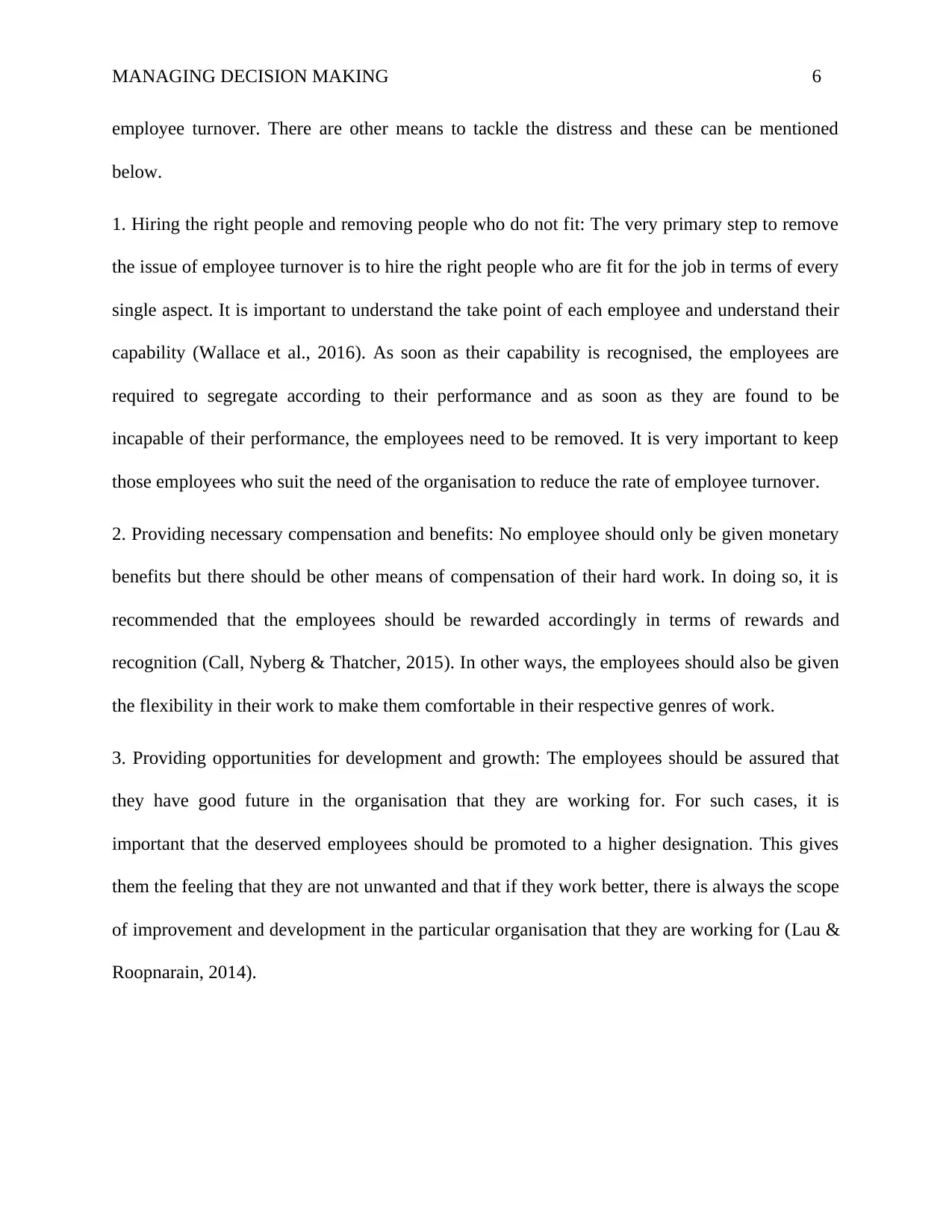
MANAGING DECISION MAKING 6
employee turnover. There are other means to tackle the distress and these can be mentioned
below.
1. Hiring the right people and removing people who do not fit: The very primary step to remove
the issue of employee turnover is to hire the right people who are fit for the job in terms of every
single aspect. It is important to understand the take point of each employee and understand their
capability (Wallace et al., 2016). As soon as their capability is recognised, the employees are
required to segregate according to their performance and as soon as they are found to be
incapable of their performance, the employees need to be removed. It is very important to keep
those employees who suit the need of the organisation to reduce the rate of employee turnover.
2. Providing necessary compensation and benefits: No employee should only be given monetary
benefits but there should be other means of compensation of their hard work. In doing so, it is
recommended that the employees should be rewarded accordingly in terms of rewards and
recognition (Call, Nyberg & Thatcher, 2015). In other ways, the employees should also be given
the flexibility in their work to make them comfortable in their respective genres of work.
3. Providing opportunities for development and growth: The employees should be assured that
they have good future in the organisation that they are working for. For such cases, it is
important that the deserved employees should be promoted to a higher designation. This gives
them the feeling that they are not unwanted and that if they work better, there is always the scope
of improvement and development in the particular organisation that they are working for (Lau &
Roopnarain, 2014).
employee turnover. There are other means to tackle the distress and these can be mentioned
below.
1. Hiring the right people and removing people who do not fit: The very primary step to remove
the issue of employee turnover is to hire the right people who are fit for the job in terms of every
single aspect. It is important to understand the take point of each employee and understand their
capability (Wallace et al., 2016). As soon as their capability is recognised, the employees are
required to segregate according to their performance and as soon as they are found to be
incapable of their performance, the employees need to be removed. It is very important to keep
those employees who suit the need of the organisation to reduce the rate of employee turnover.
2. Providing necessary compensation and benefits: No employee should only be given monetary
benefits but there should be other means of compensation of their hard work. In doing so, it is
recommended that the employees should be rewarded accordingly in terms of rewards and
recognition (Call, Nyberg & Thatcher, 2015). In other ways, the employees should also be given
the flexibility in their work to make them comfortable in their respective genres of work.
3. Providing opportunities for development and growth: The employees should be assured that
they have good future in the organisation that they are working for. For such cases, it is
important that the deserved employees should be promoted to a higher designation. This gives
them the feeling that they are not unwanted and that if they work better, there is always the scope
of improvement and development in the particular organisation that they are working for (Lau &
Roopnarain, 2014).
Paraphrase This Document
Need a fresh take? Get an instant paraphrase of this document with our AI Paraphraser
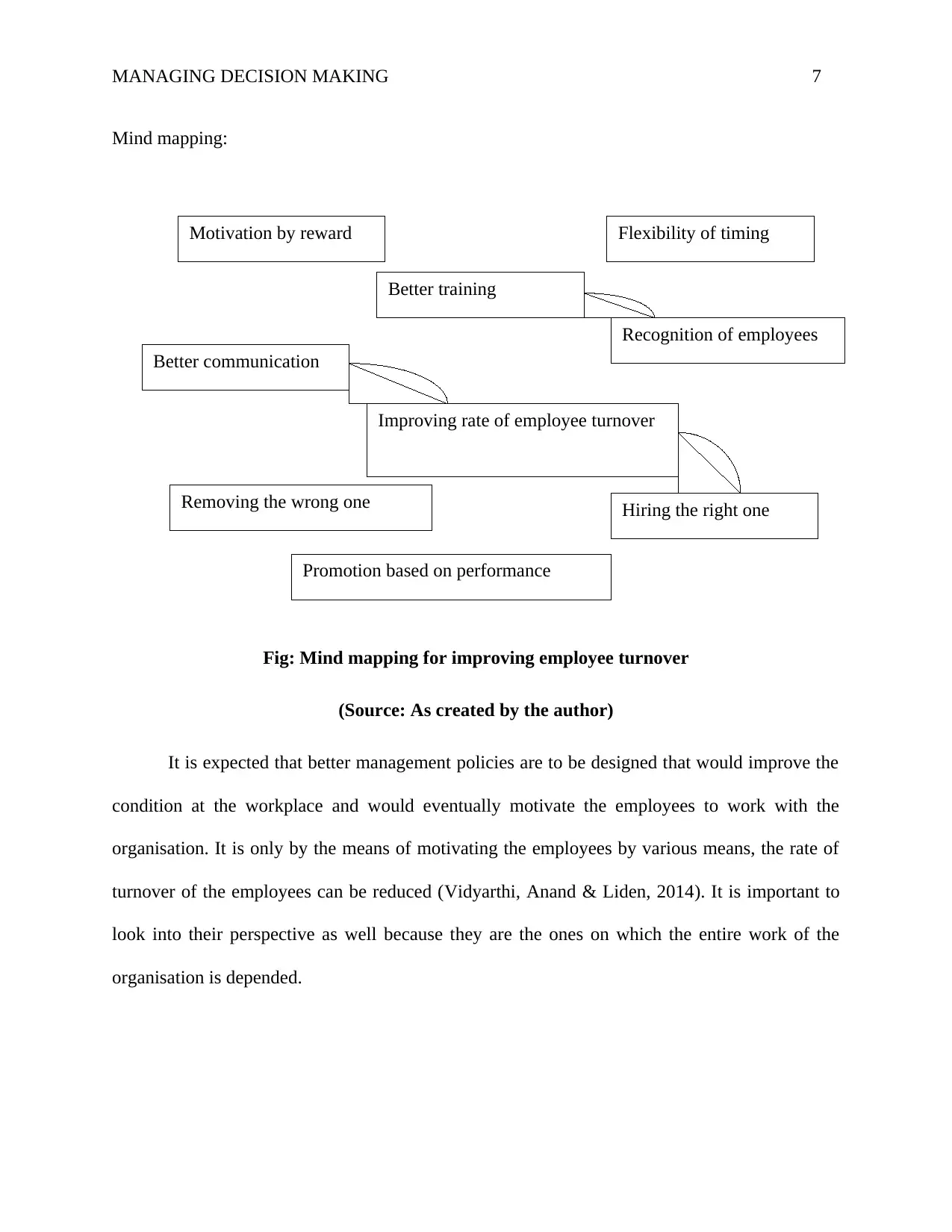
Improving rate of employee turnover
Motivation by reward
Better communication
Removing the wrong one
Better training
Flexibility of timing
Promotion based on performance
Recognition of employees
Hiring the right one
MANAGING DECISION MAKING 7
Mind mapping:
Fig: Mind mapping for improving employee turnover
(Source: As created by the author)
It is expected that better management policies are to be designed that would improve the
condition at the workplace and would eventually motivate the employees to work with the
organisation. It is only by the means of motivating the employees by various means, the rate of
turnover of the employees can be reduced (Vidyarthi, Anand & Liden, 2014). It is important to
look into their perspective as well because they are the ones on which the entire work of the
organisation is depended.
Motivation by reward
Better communication
Removing the wrong one
Better training
Flexibility of timing
Promotion based on performance
Recognition of employees
Hiring the right one
MANAGING DECISION MAKING 7
Mind mapping:
Fig: Mind mapping for improving employee turnover
(Source: As created by the author)
It is expected that better management policies are to be designed that would improve the
condition at the workplace and would eventually motivate the employees to work with the
organisation. It is only by the means of motivating the employees by various means, the rate of
turnover of the employees can be reduced (Vidyarthi, Anand & Liden, 2014). It is important to
look into their perspective as well because they are the ones on which the entire work of the
organisation is depended.
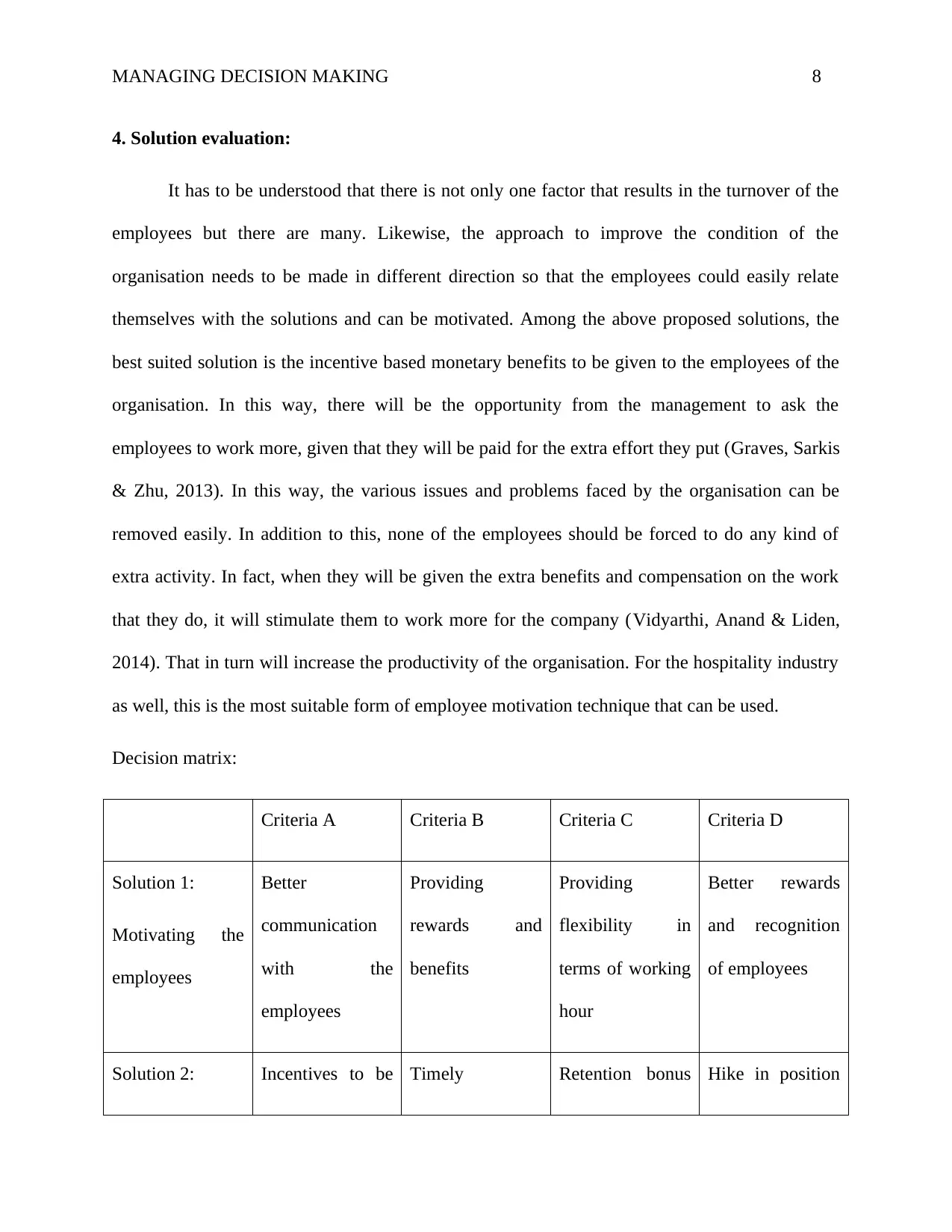
MANAGING DECISION MAKING 8
4. Solution evaluation:
It has to be understood that there is not only one factor that results in the turnover of the
employees but there are many. Likewise, the approach to improve the condition of the
organisation needs to be made in different direction so that the employees could easily relate
themselves with the solutions and can be motivated. Among the above proposed solutions, the
best suited solution is the incentive based monetary benefits to be given to the employees of the
organisation. In this way, there will be the opportunity from the management to ask the
employees to work more, given that they will be paid for the extra effort they put (Graves, Sarkis
& Zhu, 2013). In this way, the various issues and problems faced by the organisation can be
removed easily. In addition to this, none of the employees should be forced to do any kind of
extra activity. In fact, when they will be given the extra benefits and compensation on the work
that they do, it will stimulate them to work more for the company (Vidyarthi, Anand & Liden,
2014). That in turn will increase the productivity of the organisation. For the hospitality industry
as well, this is the most suitable form of employee motivation technique that can be used.
Decision matrix:
Criteria A Criteria B Criteria C Criteria D
Solution 1:
Motivating the
employees
Better
communication
with the
employees
Providing
rewards and
benefits
Providing
flexibility in
terms of working
hour
Better rewards
and recognition
of employees
Solution 2: Incentives to be Timely Retention bonus Hike in position
4. Solution evaluation:
It has to be understood that there is not only one factor that results in the turnover of the
employees but there are many. Likewise, the approach to improve the condition of the
organisation needs to be made in different direction so that the employees could easily relate
themselves with the solutions and can be motivated. Among the above proposed solutions, the
best suited solution is the incentive based monetary benefits to be given to the employees of the
organisation. In this way, there will be the opportunity from the management to ask the
employees to work more, given that they will be paid for the extra effort they put (Graves, Sarkis
& Zhu, 2013). In this way, the various issues and problems faced by the organisation can be
removed easily. In addition to this, none of the employees should be forced to do any kind of
extra activity. In fact, when they will be given the extra benefits and compensation on the work
that they do, it will stimulate them to work more for the company (Vidyarthi, Anand & Liden,
2014). That in turn will increase the productivity of the organisation. For the hospitality industry
as well, this is the most suitable form of employee motivation technique that can be used.
Decision matrix:
Criteria A Criteria B Criteria C Criteria D
Solution 1:
Motivating the
employees
Better
communication
with the
employees
Providing
rewards and
benefits
Providing
flexibility in
terms of working
hour
Better rewards
and recognition
of employees
Solution 2: Incentives to be Timely Retention bonus Hike in position
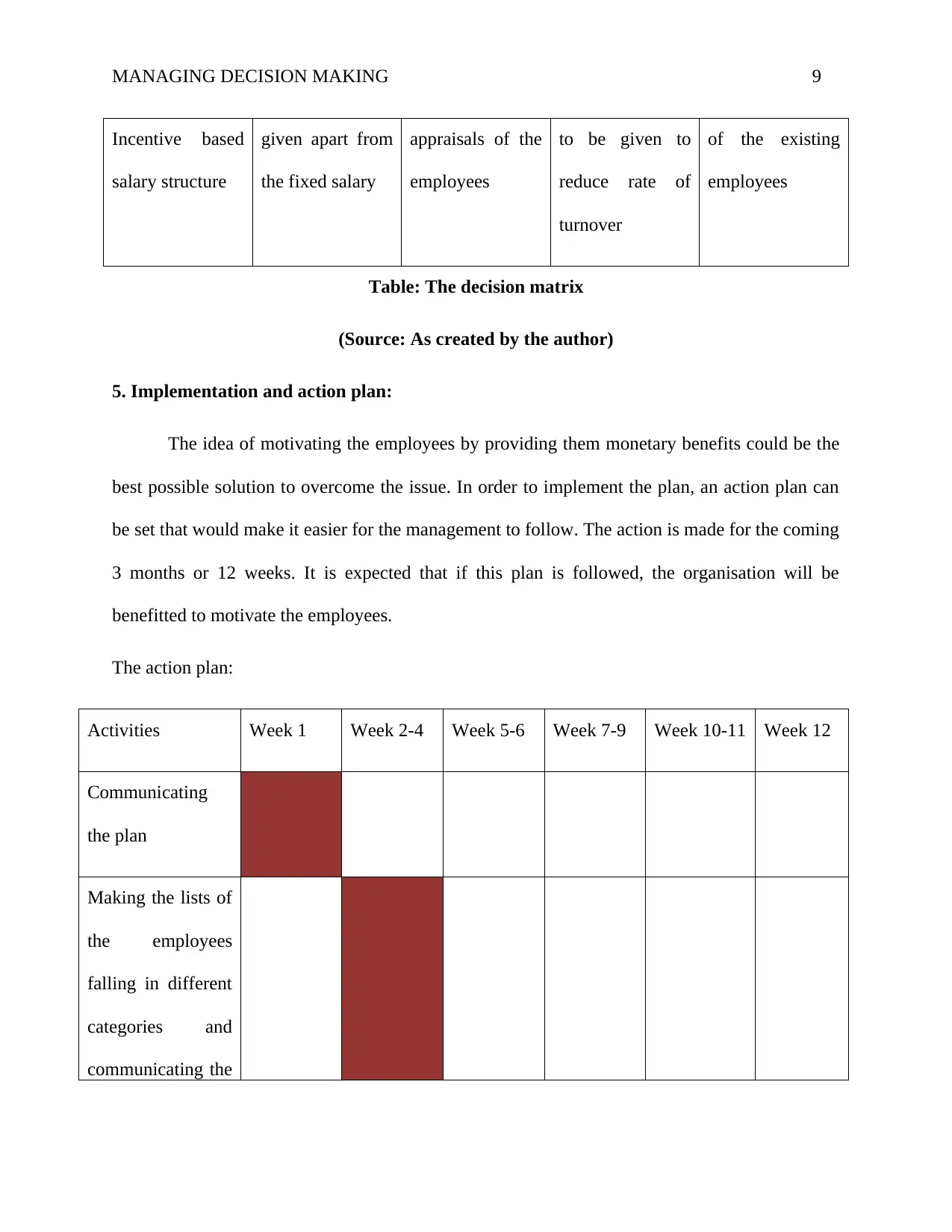
MANAGING DECISION MAKING 9
Incentive based
salary structure
given apart from
the fixed salary
appraisals of the
employees
to be given to
reduce rate of
turnover
of the existing
employees
Table: The decision matrix
(Source: As created by the author)
5. Implementation and action plan:
The idea of motivating the employees by providing them monetary benefits could be the
best possible solution to overcome the issue. In order to implement the plan, an action plan can
be set that would make it easier for the management to follow. The action is made for the coming
3 months or 12 weeks. It is expected that if this plan is followed, the organisation will be
benefitted to motivate the employees.
The action plan:
Activities Week 1 Week 2-4 Week 5-6 Week 7-9 Week 10-11 Week 12
Communicating
the plan
Making the lists of
the employees
falling in different
categories and
communicating the
Incentive based
salary structure
given apart from
the fixed salary
appraisals of the
employees
to be given to
reduce rate of
turnover
of the existing
employees
Table: The decision matrix
(Source: As created by the author)
5. Implementation and action plan:
The idea of motivating the employees by providing them monetary benefits could be the
best possible solution to overcome the issue. In order to implement the plan, an action plan can
be set that would make it easier for the management to follow. The action is made for the coming
3 months or 12 weeks. It is expected that if this plan is followed, the organisation will be
benefitted to motivate the employees.
The action plan:
Activities Week 1 Week 2-4 Week 5-6 Week 7-9 Week 10-11 Week 12
Communicating
the plan
Making the lists of
the employees
falling in different
categories and
communicating the
Secure Best Marks with AI Grader
Need help grading? Try our AI Grader for instant feedback on your assignments.
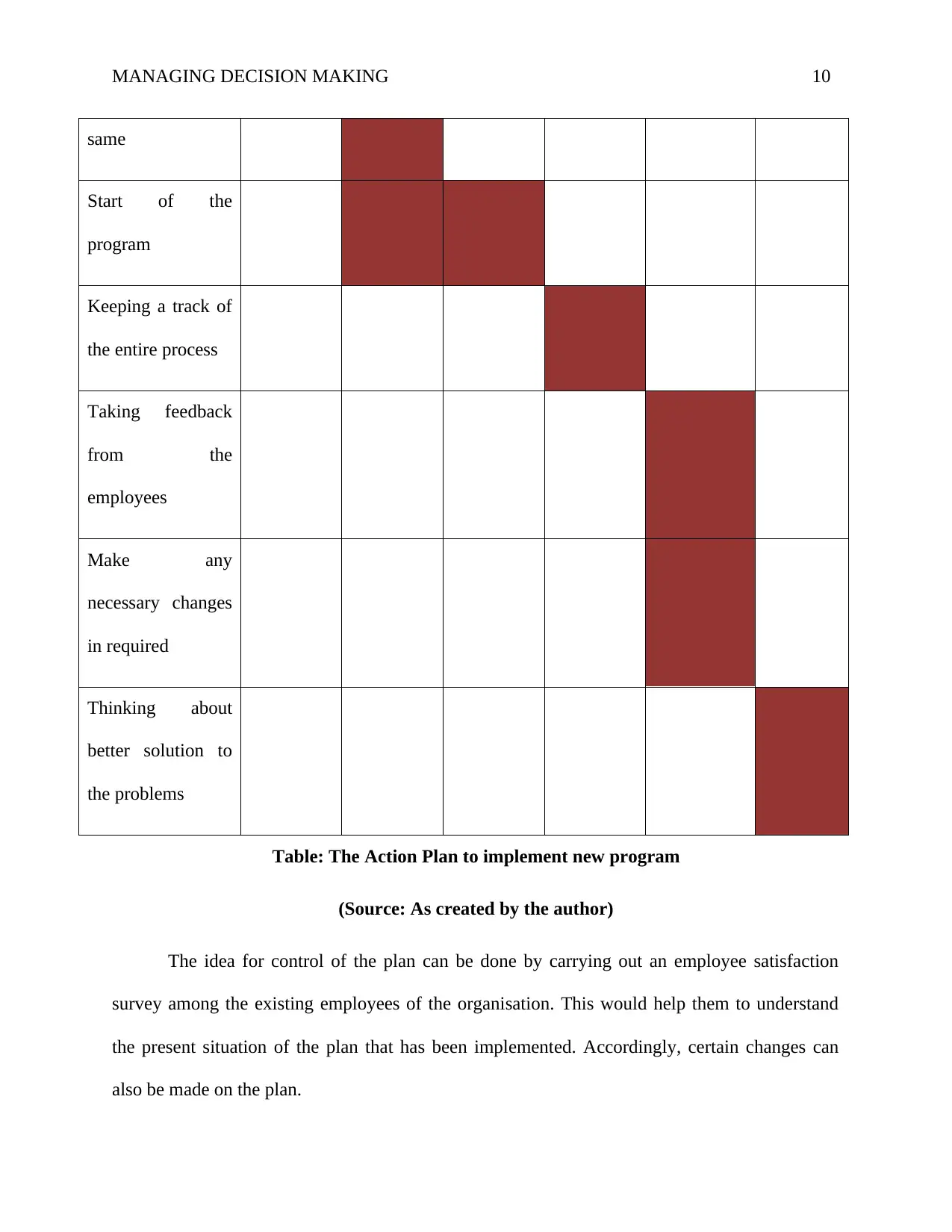
MANAGING DECISION MAKING 10
same
Start of the
program
Keeping a track of
the entire process
Taking feedback
from the
employees
Make any
necessary changes
in required
Thinking about
better solution to
the problems
Table: The Action Plan to implement new program
(Source: As created by the author)
The idea for control of the plan can be done by carrying out an employee satisfaction
survey among the existing employees of the organisation. This would help them to understand
the present situation of the plan that has been implemented. Accordingly, certain changes can
also be made on the plan.
same
Start of the
program
Keeping a track of
the entire process
Taking feedback
from the
employees
Make any
necessary changes
in required
Thinking about
better solution to
the problems
Table: The Action Plan to implement new program
(Source: As created by the author)
The idea for control of the plan can be done by carrying out an employee satisfaction
survey among the existing employees of the organisation. This would help them to understand
the present situation of the plan that has been implemented. Accordingly, certain changes can
also be made on the plan.
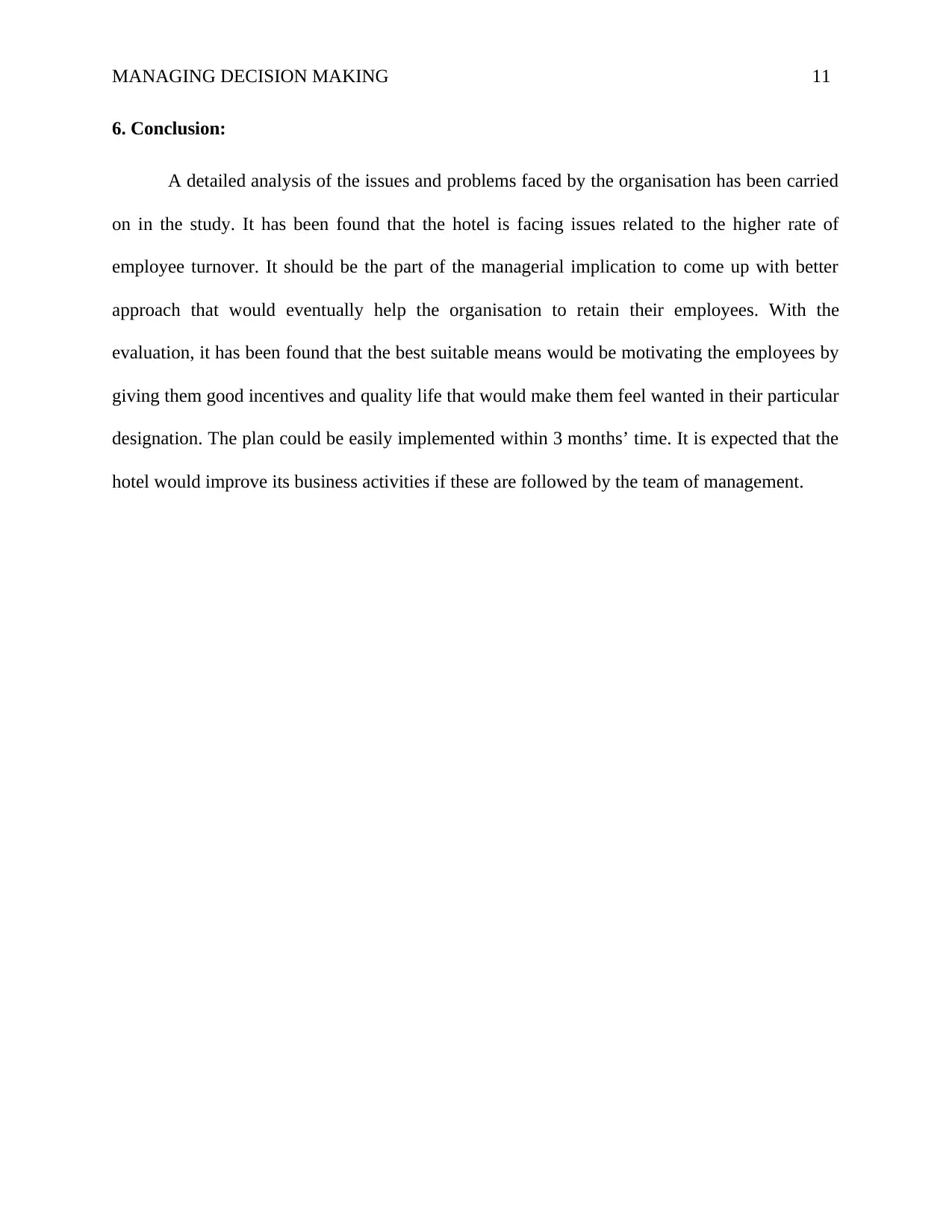
MANAGING DECISION MAKING 11
6. Conclusion:
A detailed analysis of the issues and problems faced by the organisation has been carried
on in the study. It has been found that the hotel is facing issues related to the higher rate of
employee turnover. It should be the part of the managerial implication to come up with better
approach that would eventually help the organisation to retain their employees. With the
evaluation, it has been found that the best suitable means would be motivating the employees by
giving them good incentives and quality life that would make them feel wanted in their particular
designation. The plan could be easily implemented within 3 months’ time. It is expected that the
hotel would improve its business activities if these are followed by the team of management.
6. Conclusion:
A detailed analysis of the issues and problems faced by the organisation has been carried
on in the study. It has been found that the hotel is facing issues related to the higher rate of
employee turnover. It should be the part of the managerial implication to come up with better
approach that would eventually help the organisation to retain their employees. With the
evaluation, it has been found that the best suitable means would be motivating the employees by
giving them good incentives and quality life that would make them feel wanted in their particular
designation. The plan could be easily implemented within 3 months’ time. It is expected that the
hotel would improve its business activities if these are followed by the team of management.
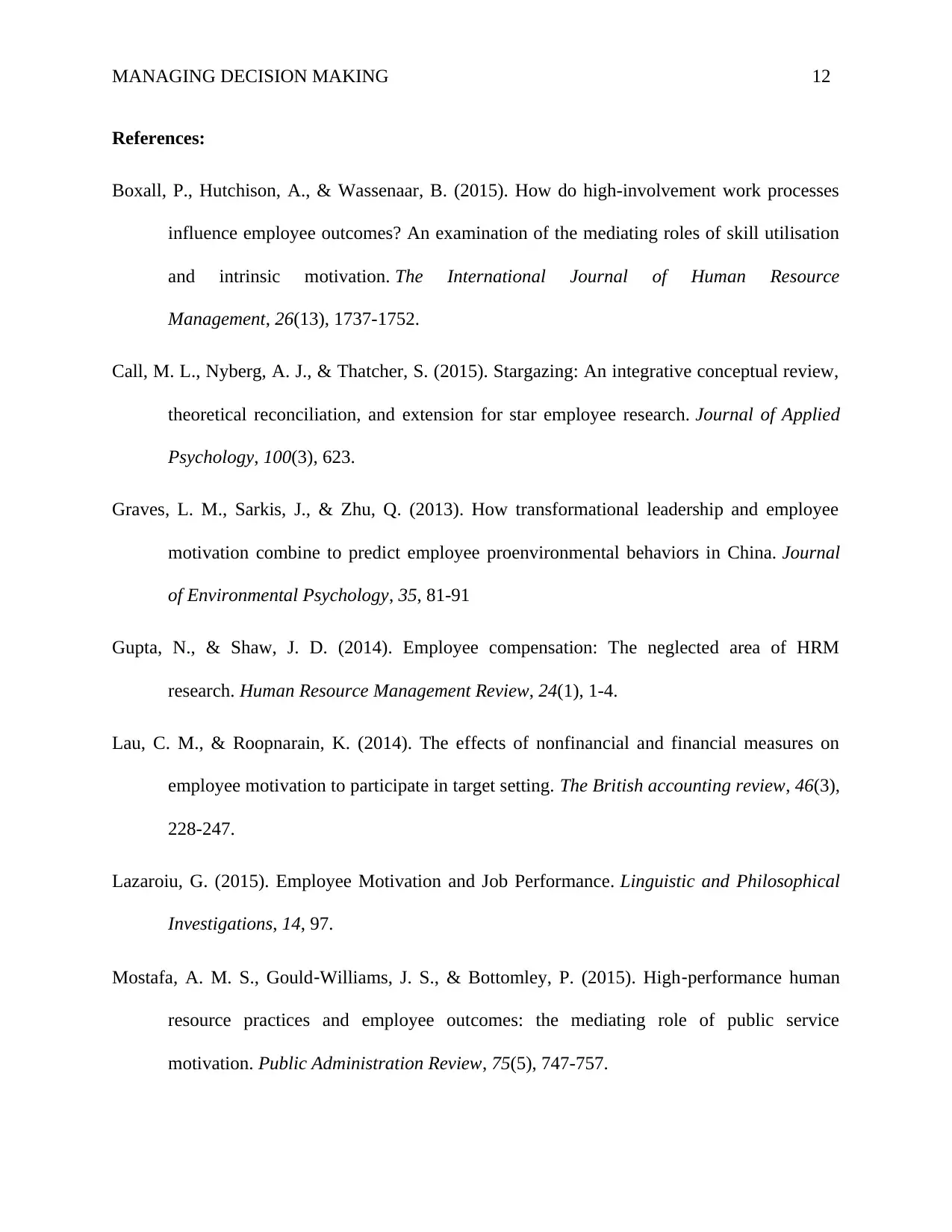
MANAGING DECISION MAKING 12
References:
Boxall, P., Hutchison, A., & Wassenaar, B. (2015). How do high-involvement work processes
influence employee outcomes? An examination of the mediating roles of skill utilisation
and intrinsic motivation. The International Journal of Human Resource
Management, 26(13), 1737-1752.
Call, M. L., Nyberg, A. J., & Thatcher, S. (2015). Stargazing: An integrative conceptual review,
theoretical reconciliation, and extension for star employee research. Journal of Applied
Psychology, 100(3), 623.
Graves, L. M., Sarkis, J., & Zhu, Q. (2013). How transformational leadership and employee
motivation combine to predict employee proenvironmental behaviors in China. Journal
of Environmental Psychology, 35, 81-91
Gupta, N., & Shaw, J. D. (2014). Employee compensation: The neglected area of HRM
research. Human Resource Management Review, 24(1), 1-4.
Lau, C. M., & Roopnarain, K. (2014). The effects of nonfinancial and financial measures on
employee motivation to participate in target setting. The British accounting review, 46(3),
228-247.
Lazaroiu, G. (2015). Employee Motivation and Job Performance. Linguistic and Philosophical
Investigations, 14, 97.
Mostafa, A. M. S., Gould‐Williams, J. S., & Bottomley, P. (2015). High‐performance human
resource practices and employee outcomes: the mediating role of public service
motivation. Public Administration Review, 75(5), 747-757.
References:
Boxall, P., Hutchison, A., & Wassenaar, B. (2015). How do high-involvement work processes
influence employee outcomes? An examination of the mediating roles of skill utilisation
and intrinsic motivation. The International Journal of Human Resource
Management, 26(13), 1737-1752.
Call, M. L., Nyberg, A. J., & Thatcher, S. (2015). Stargazing: An integrative conceptual review,
theoretical reconciliation, and extension for star employee research. Journal of Applied
Psychology, 100(3), 623.
Graves, L. M., Sarkis, J., & Zhu, Q. (2013). How transformational leadership and employee
motivation combine to predict employee proenvironmental behaviors in China. Journal
of Environmental Psychology, 35, 81-91
Gupta, N., & Shaw, J. D. (2014). Employee compensation: The neglected area of HRM
research. Human Resource Management Review, 24(1), 1-4.
Lau, C. M., & Roopnarain, K. (2014). The effects of nonfinancial and financial measures on
employee motivation to participate in target setting. The British accounting review, 46(3),
228-247.
Lazaroiu, G. (2015). Employee Motivation and Job Performance. Linguistic and Philosophical
Investigations, 14, 97.
Mostafa, A. M. S., Gould‐Williams, J. S., & Bottomley, P. (2015). High‐performance human
resource practices and employee outcomes: the mediating role of public service
motivation. Public Administration Review, 75(5), 747-757.
Paraphrase This Document
Need a fresh take? Get an instant paraphrase of this document with our AI Paraphraser
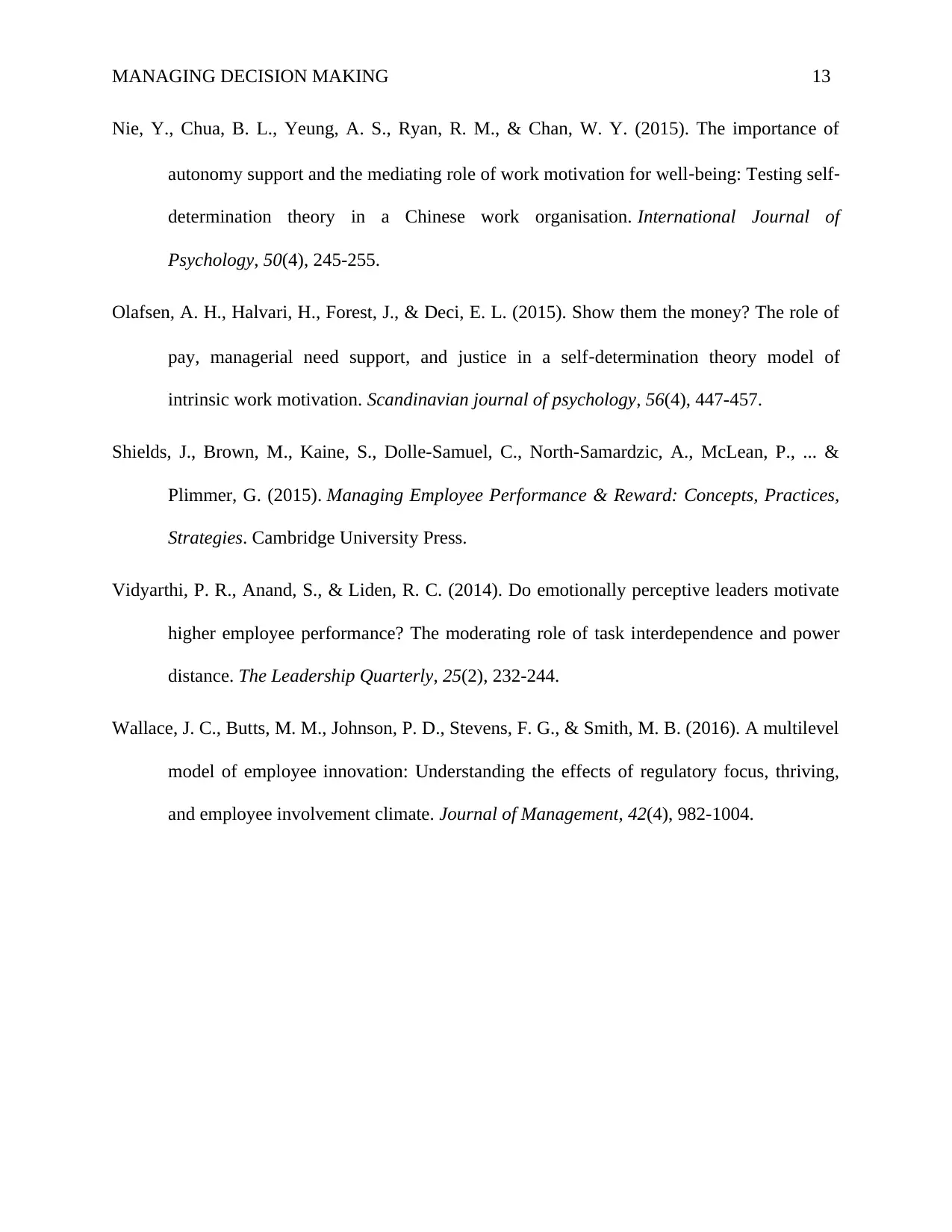
MANAGING DECISION MAKING 13
Nie, Y., Chua, B. L., Yeung, A. S., Ryan, R. M., & Chan, W. Y. (2015). The importance of
autonomy support and the mediating role of work motivation for well‐being: Testing self‐
determination theory in a Chinese work organisation. International Journal of
Psychology, 50(4), 245-255.
Olafsen, A. H., Halvari, H., Forest, J., & Deci, E. L. (2015). Show them the money? The role of
pay, managerial need support, and justice in a self‐determination theory model of
intrinsic work motivation. Scandinavian journal of psychology, 56(4), 447-457.
Shields, J., Brown, M., Kaine, S., Dolle-Samuel, C., North-Samardzic, A., McLean, P., ... &
Plimmer, G. (2015). Managing Employee Performance & Reward: Concepts, Practices,
Strategies. Cambridge University Press.
Vidyarthi, P. R., Anand, S., & Liden, R. C. (2014). Do emotionally perceptive leaders motivate
higher employee performance? The moderating role of task interdependence and power
distance. The Leadership Quarterly, 25(2), 232-244.
Wallace, J. C., Butts, M. M., Johnson, P. D., Stevens, F. G., & Smith, M. B. (2016). A multilevel
model of employee innovation: Understanding the effects of regulatory focus, thriving,
and employee involvement climate. Journal of Management, 42(4), 982-1004.
Nie, Y., Chua, B. L., Yeung, A. S., Ryan, R. M., & Chan, W. Y. (2015). The importance of
autonomy support and the mediating role of work motivation for well‐being: Testing self‐
determination theory in a Chinese work organisation. International Journal of
Psychology, 50(4), 245-255.
Olafsen, A. H., Halvari, H., Forest, J., & Deci, E. L. (2015). Show them the money? The role of
pay, managerial need support, and justice in a self‐determination theory model of
intrinsic work motivation. Scandinavian journal of psychology, 56(4), 447-457.
Shields, J., Brown, M., Kaine, S., Dolle-Samuel, C., North-Samardzic, A., McLean, P., ... &
Plimmer, G. (2015). Managing Employee Performance & Reward: Concepts, Practices,
Strategies. Cambridge University Press.
Vidyarthi, P. R., Anand, S., & Liden, R. C. (2014). Do emotionally perceptive leaders motivate
higher employee performance? The moderating role of task interdependence and power
distance. The Leadership Quarterly, 25(2), 232-244.
Wallace, J. C., Butts, M. M., Johnson, P. D., Stevens, F. G., & Smith, M. B. (2016). A multilevel
model of employee innovation: Understanding the effects of regulatory focus, thriving,
and employee involvement climate. Journal of Management, 42(4), 982-1004.
1 out of 14
Related Documents
Your All-in-One AI-Powered Toolkit for Academic Success.
+13062052269
info@desklib.com
Available 24*7 on WhatsApp / Email
![[object Object]](/_next/static/media/star-bottom.7253800d.svg)
Unlock your academic potential
© 2024 | Zucol Services PVT LTD | All rights reserved.





